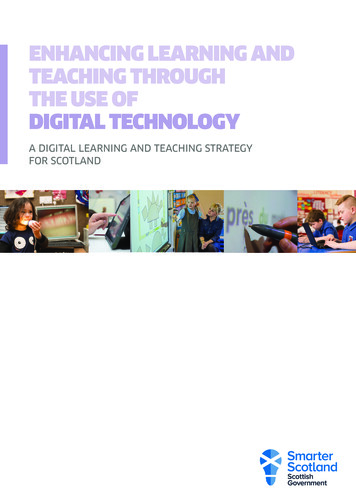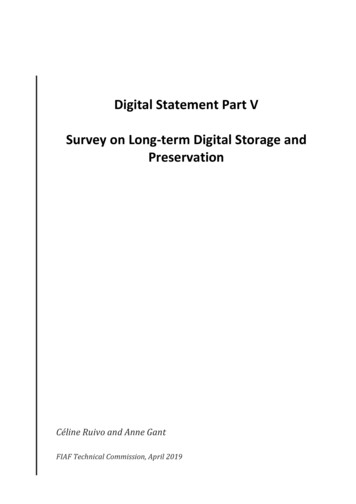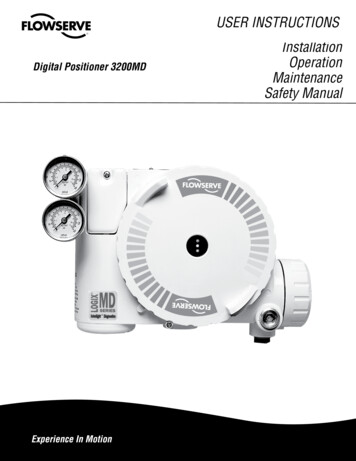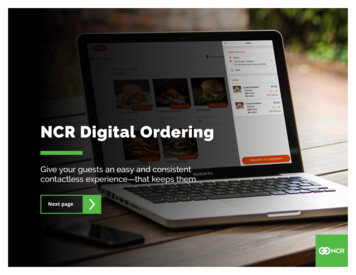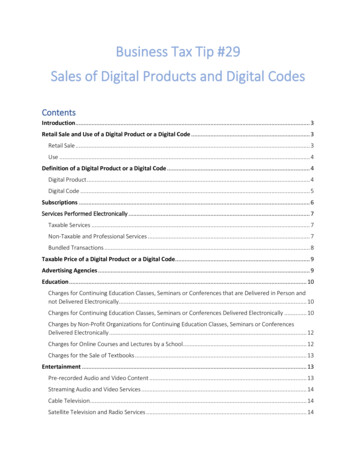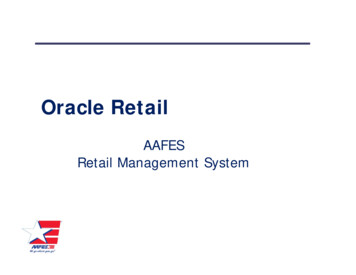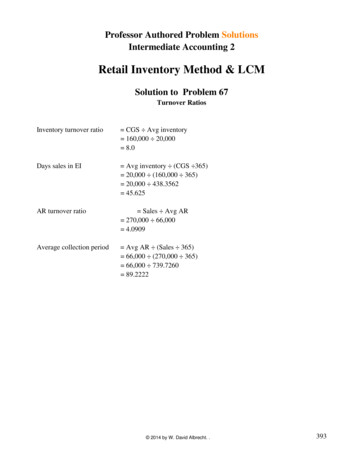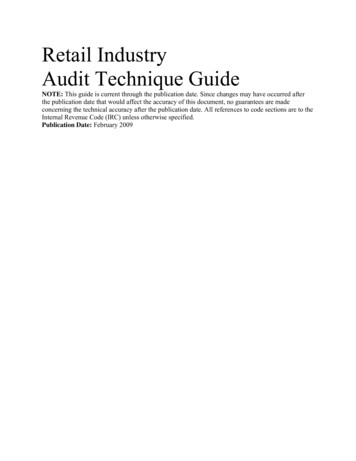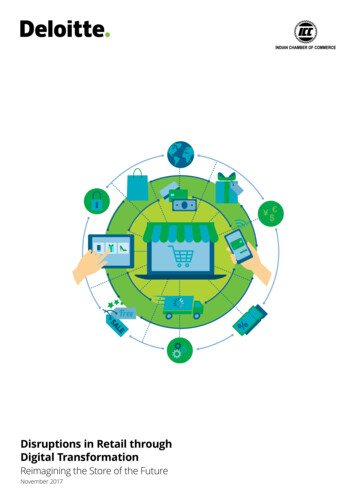
Transcription
Disruptions in Retail throughDigital TransformationReimagining the Store of the FutureNovember 2017
Disruptions in Retail through Digital TransformationMessage from ICC RetailSummit ChairThe word “Innovative Disruption”, toquote from Mr. Clayton Christensen, theAuthor of “Innovator’s Dilemma”, refersto an organization or entrepreneuranticipating Customer’s needs,passionately falling in love withCustomer and creating a market wherenone existed. The rapid pace of suchdisruptions mostly shake up establishedtraditional business models and makethe earlier known Rules of Success orGrowth redundant in today’s “Phygital”connected world especially Retail.Technology is getting intertwined andbecoming seamless in both B2B as wellas B2C experiences. Cycle times andPlanning times are expected to shrinkas complex processes get reconfiguredthrough Bots and concepts like AI andIOTs.With this backdrop and booming outlookfor growth, Retail Sector in India isclearly poised to become one of thelargest beneficiaries of the disruptiveera that has begun. ICC is proud toassociate with Deloitte team whohave taken the efforts to bring out the“knowledge paper” on “Disruptive DigitalTransformation in Retail” which willimmensely benefit the businesses, Startups to SMEs to large enterprises and thevarious stakeholders in their journey ofexciting growth ahead.We wish to thank the Deloitte leadershipteam for the extensive work doneincluding the interactions with Retailindustry leadership teams in variousCompanies.ICC is also delighted to host its FirstRetail Summit in Southern India andI thank the ICC leadership and MCmembers for the Initiative!All the best,S KANNANSUMMIT CHAIR01
Disruptions in Retail through Digital TransformationKONNECTED to consumersForeword by DeloitteThe modern economy has been builton the foundations of the industrialrevolution with its roots in scientificconcepts of deductive reasoning andthe economic logic of maximizing selfinterest. Digital has helped build aparallel narrative of inductive doctrineswhere focus is on looking at convergencebetween sectors, breaking downfunctional silos within organizationsby customer-centric, opportunitiesto collaborate even with competitionby developing a co-opetition mindset,co-ownership of investments throughfranchisees/alliances for scalable growthwith low levels of asset intensity, buildingrelationships with the new generationof inter-connected customers who areinvolved in co-creation of products/services and a long term orientation ofcontinuous learning through feedbackto better improve the customer deliverymodel.Retailers have had two options in theway they have responded to the digitalopportunity. A vast majority have seendigital as an enabler of better customerservice or greater operational efficiencyand have hence implemented manydigital technologies to improve their02performance on these parameters. Thisapproach is an incremental response tothe opportunities presented by digitaland is primarily driven by a low riskpropensity to allocate scarce resources towhat can be a fundamental disruptor tothe business model of retailers. However,there have been a few retailers whohave truly awoken to the possibilitiespresented by Digital. They have seendigital as an opportunity to shape a longterm sustainable business model whichis a departure from the paradigms of thepast.Integral to this digital approach is theview of the retail eco-system as a networkof suppliers and franchisees supportingthe central actor (retailer) in orchestratinga business model with the long termobjective of maximizing customerlifetime value and not just focused on atransactional approach. The fundamentaltenets of this approach is a collaborativemindset where the retailer is the firstamong equals in the wider networkwho invests in building the capabilitiesof the entire network to be agile andresponsive to consumer needs. Attractingand retaining shoppers is the sharedobjective of the entire network anddigital technologies help to understandconsumer needs (e.g.: cognitive),provide greater assortment (e.g.: Visualmerchandising), help shoppers decide(e.g.: Virtual Trial Rooms), lower cost(e.g.: robotics & process automation),increase loyalties (e.g.: blockchain) andenhance customer service (e.g.: AI baseself-learning systems). However the riskis to view digital only through this prismof technology investments. At the coreof digital for any retailer is a wider abilityto build a culture of collaboration, thecapability of using data to break throughfunctional and organizational boundaries,the art of using technology to unearthnew possibilities for enhanced customervalue and in the process completelyreimagine the store of the future Anand RamanathanPartner, Deloitte
Disruptions in Retail through Digital TransformationExecutive SummaryDigital provides opportunities forretailers to acquire new customers,engage better with existing customers,reduce the cost of operations, andimprove employee motivation alongwith various other benefits that have apositive influence from a revenue andmargin perspective.For the purpose of this report, digitalhas been defined as a technologyenabled combination of resources (caninclude instruments, devices, bots,tools, teams, protocols, processes,networks, methodologies) which enablesthe availability of content (can be data,information, expert/social reviews,reports, analysis, games) for the user(employee or customer) to make moreproductive (can impact cost, time orservice level) decisions and satisfyingchoices.The ability to collect, process and sharelarge quantities of data has led to somefundamental disruptions in the designof business models. The key factorsimpacting this change include: Convergence: The traditionalboundaries between sectorsis collapsing. Innovation at theboundaries of sectors such aspayment systems (Financial Services& Telecom), e-commerce (Retail& Telecom), Industry 4.0 (ICT andManufacturing) etc. is fundamentallydisrupting businesses. Any disruptiveapproach in digital transformation forretail hence, needs to factor in a multi-disciplinary view of implementationwith a mix of analytical and creativecapabilities Customer Centricity: Functionalboundaries within organizationsare also being dismantled to alignstructures to customer needs. Theprocess has been further acceleratedthrough digital as big data is nowmaking it possible to analyze shopperbehavior in great detail and customizethe delivery format to individualconsumer requirements throughpersonalization Co-opetition: This is a revolutionarymindset that combines competitionwith collaboration. Suppliers andretailers are no longer competing forlimited resources but are workingtogether to profit from enhancedcustomer value being delivered.There have been several instances ofcollaboration between retailers evenfrom an India context (e.g.: FutureGroup and Flipkart) Co-ownership: From a retail contextdigital has helped monitor and controlquality in franchising agreementsto achieve greater alignment ofthe business model to shopperrequirements presenting an enhancedopportunity for retailers to drive scaleat a fast clip without compromisingon the brand promise and sharing theinvestment burden with their partnerspeers and is more willing than everbefore to share experiences and letothers profit from his/her interactionswith products/services. Consumershelp co-create the value propositionbasis their willingness to providefeedback which helps refine deliverymodels on an ongoing real time basis. Continuous learning: Self learningsystems through AI and cognitivemodelling has enabled feedback frompast experiences to optimize theshopping experience for consumersand hence impacting satisfaction andloyalty to be enhanced.This report focuses on the impact ofDigital on three key elements of theretail business & operating model:1. Strategy – includes elements ofsegmentation, positioning, operatingformats and business models(location, assortment, size, pricing)2. Front end - Customer facingoperations including store front,Merchandising & Promotion,Customer experience includingLoyalty, Marketing andCommunications, Pricing & POSSolutions3. Back end – Supply Chain, Logistics &Warehousing, Digital Procurement& Vendor management, Assortmentmix & planning, People, FinanceAutomation Co-creation: The new digital shopperis highly interconnected with his social03
Disruptions in Retail through Digital TransformationTraditional Retailers Store of the future.Illustrative ExamplesSegmentationAdopt mass, demographybased segmentationUse data Analytics for microsegmentation Provide personalizedofferings Targeted communicationAdvanced AI basedanalytics to create customermicrosegmentsPositioningCompete on price and qualityalone Offer additional services &facilities Leisure provisions andshopping environment ConvenienceTheme-based digitallyenhanced experiential storesOperatingFormatsPredominantly Brick & Mortarled with a catchment-focusDisruptive & innovativeformats aided by digitalinitiatives to expand reach(Omni channel approach)On-demand grocery deliveryBusiness ModelsAdopt single dimensionalbusiness modelsDisruptive business modelsusing digital enablersSubscription model,Hypermarket modelTraditional Retailers Store of the future.Illustrative ExamplesCustomerExperience Emphasize functionalityacross touchpoints Focus on in-store journeyHolistic physical and digitalexperience across entirecustomer journeySmart mirrors for providingvirtual trials to shoppersMerchandizingFocus on customerengagement through: Visual Merchandizing Store layoutsDigital merchandizingtechniques – Virtual fitting rooms Digital kiosks Augmented RealityVirtual trial rooms and 3D tryon facilityLoyaltyProgramsFocus on: Traditional loyalty programslike stamps on cardsShift towards: Mobile app based programs Virtual reality tie ups Blockchain based loyaltyprogramsBlock-chain based loyaltyprogramsPricing and POSsolutionsRely on traditional pricingmethods Advanced dynamic pricingstrategies Customized engagementand personalized deals forcustomersUse of electronic shelf-edgetechnologyWhere to Play?StrategyWhere to Play?Front end04
Disruptions in Retail through Digital TransformationTraditional Retailers Store of the future.Illustrative ExamplesSupply ChainLinear supply chainsShift towards a dynamic,integrated supply network Digital Supply Networks“Always-on” agile supply chainLogistics &WarehousingTraditional logistics andwarehouse managementShift to: Shared logistics capabilities Digitally enabled logisticsservices Continuous automatedmonitoringDrone based deliveriesFinanceConventional financialreporting and managementShift towards: Use of RPA to automatefinancial functions IOT-enabled processesCrypto currencies such asBitcoinsProcurementand VendorManagementFocus on: Traditional suppliercustomer relationshipsShift to: Collaboration with vendorsfor successBlock-chain technology forcontract management &supplier paymentsAssortment-mix& PlanningDecisions basis Experience & judgement Ad-hoc assortmentprioritization Historical baselinesRetailers use: Data-driven algorithms forstore’s assortment planning Adopt predictive models &real-time forecasting Use dark analyticsRFID chips to make supplychain more responsivePeople &OrganizationStructure Traditional ways oftraining and managingresources Adopted in isolation andbased on historical values Simplifying employeeprocesses throughautomation Digital retail transformingKPIs being used to measureand reward staffAdoption of smart systemsto manage staff shifts andcheckout proceduresBack end05
Disruptions in Retail through Digital TransformationCollaborative Mindset for DigitalCollaboration TypeKey Collaboration Areasleading to higher valuecreationSelect ExamplesSupplier – Supplier Coopetition (Collaboration Microsoft and Intel tie up leading to a synergistic growth in sales forwith competition)both software as well as the chips Google and Mozilla working together (Google funded Mozilla’s free,open-source Firefox web browser – a Chrome rival – to limit theinfluence of rival browsers, Microsoft’s Internet Explorer and Apple’sSafari) Refrigerants Naturally is a non-profit that was established by fiercecompetitors Coca-Cola, Pepsi Co, Red Bull, Unilever and others towork jointly to develop sustainable refrigeration technologies to combatclimate change and ozone depletionSupplier – Retailer Revenue MarginEnhancement Process Improvement Cost Reduction Sharing of POS data realtime Creation of ecosystems Kellogg with Tesco: Examining real time POS data to identifypurchasing patterns at certain Tesco supermarkets. Adjustment in itsshipping schedule helped Tesco recapture more than 2 million (US 4million) in lost sales and improve customer satisfaction Kraft Foods Inc. used U.K. food retailer J Sainsbury PLC’s POS data toimprove in-store availability of cheeses during promotional periods Apple ties up with Reliance Retail for special offers and plansRetailer – Retailer Extended networks New channels Walmart plans tie ups with Flipkart, Amazon to tap the online retailopportunity Paytm ties up with offline electronic stores to list them on their onlineplatformRetailer – Customer Co-creation of consumerfocused content Crowdsourcing forinnovation LEGO Ideas is an online community where members can discovercreations by other fans and submit their own designs for new setsRetailer – DigitalEcosystem Player Consumer centric solution Walmart and Google tie up for voice controlled shopping - Google, willdevelopmentoffer hundreds of thousands of Walmart items on its voice-controlledGoogle Assistant platformThe digital age presents opportunities for retailers to bring in greater levels of operational efficiency and customer centricity intheir business models. Digital is as much about people and mindsets as it is about technology. Hence it is imperative that thedigital agenda in any retailer organiz
Strategy – includes elements of segmentation, positioning, operating formats and business models (location, assortment, size, pricing) 2. Front end - Customer facing operations including store front, Merchandising & Promotion, Customer experience including Loyalty, Marketing and Communications, Pricing & POS Solutions 3. Back end – Supply Chain, Logistics & Warehousing, Digital Procurement .

